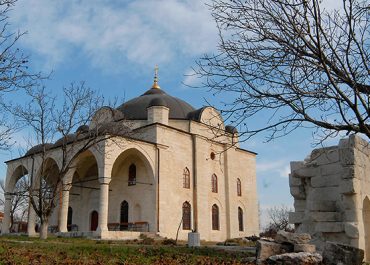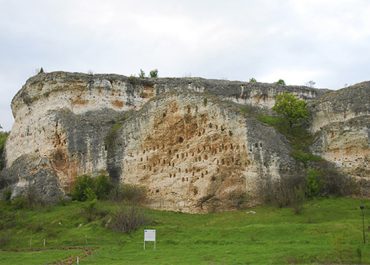
Medieval Fortress near the village of Mezek
Near the village of Mezek (Svilengrad Municipality), on the Kaleto hill stand the ruins of a medieval Byzantine fortress from the end of the 11th century AD. It is the best-preserved defensive installation in the Rhodope mountain. The fortress had the functions of a border guarding fortress. It defended the territories between the rivers Maritza and Arda. It is located at the end of Mezek village, 6 kilometers southwest of Svilengrad and only a kilometer of the border with Greece.
Some historians believe that this is the famous fortress Neutzikon, known from written sources; others believe that at that place lied the Versinikiya fortress, where Khan Krum defeated the Byzantine army in 813 AD and conquered Thrace.
Objects, dating back to the 11th century were found during several archaeological excavations. The fortress is believed to be constructed during the reign of the Byzantine Emperor Alexius I Comnenus (1081 – 1117). The fortress walls surround an area of about 7 decares in the shape of an irregular rectangle with sizes of 110/60 meters and are built of stones, soldered with white plaster, decorated with three brick bands on the outside. The fortress wall ended with pinnacles, which were preserved until 1900.
The fortress defense was reinforced by nine round towers, over 10 meters high. Five of the towers were located at the southern wall (two edge towers and three on the front), two at the western wall (in the middle and at the main entrance), one at the northern and one at the eastern wall. The fortress functioned until the Ottoman invasion at the end of the 14th century. It was planned to be a solid fortification unit and was a home to many people. Several granaries with charred corn were found, where food supplies used to be stored. Numerous are the discovered iron arrowheads, spurs and horseshoes, which testify the presence of garrison soldiers. Stone mills, metal instruments and other items tell us about the way of life of the ordinary people.
The fortress near the village of Mezek was quite well preserved until the beginning of the 20th century. A part of it was destroyed by 1900, when stones were taken from it to build the Turkish barracks in Svilengrad. The northern wall suffered the most. It is preserved at the terrain level at the inner side. The southern, western and eastern walls are conserved at the height of the platform, where the pinnacles stood.
The fortress was declared national antiquity and an architectural building monument of the ancient and medieval times; the declaration was promulgated in the State Gazette, in issue 221/1927 and issue 67/1968. Restoration and conservation activities were carried out in 1973 and 2007. A tourist information center, offering information and brochures, was built.
Besides the view to the village and the surrounding area, in clear weather from the towers, a view of the Aegean Sea can be seen.
Mezek village is located about 11 kilometers southwest of Svilengrad. Its name was documented for the first time in the Ottoman registries in 1582 AD. After the liberation of Bulgaria in 1878, under the Berlin Treaty, the village of Mezek remained within the borders of the Ottoman Empire. In 1913, the Bucharest treaty returned Mezek to Bulgaria.
The tourist path from the village to Sheynovets peak guides the nature and history admirers to the place where in 1912 the Balkan war started.
The village offers a diversity of accommodation and restaurants.
Monday-Sunday 09:30 – 20:00 / summer working hours /
Monday – Sunday 10:00 – 17:00 / winter working hours /
Travel from the Municipality in Svilengrad in the direction of the old bridge at Maritsa river. Leave the town through Garata quarter, pass “Lav Cheshma”, follow the highway to Greece and turn right to the village of Mezek. The signs near the road will lead you to the fortress.
The tourist center offers guides and guided tours in Bulgarian language.
Art gallery and tourist information center-Svilengrad
6500 Svilengrad, 11 Krayrechna Str
Tel:
+359 889 044 016
+359 886 000 726
Historical Museum – Svilengrad
6500 Svilengrad, 150 Bulgaria Blvd.
Tel: +359 37 971 097
E-mail: museum@svilengradmuseum.com
Website: http://svilengradmuseum.com/
6550 Lyubimets, Strumica 16
Tel: +359 886 000 726
Email: office@visitsvilengrad.com
Website: http://visitsvilengrad.com/
Near the village of Mezek (Svilengrad Municipality), on the Kaleto hill stand the ruins of a medieval Byzantine fortress from the end of the 11th century AD. It is the best-preserved defensive installation in the Rhodope mountain. The fortress had the functions of a border guarding fortress. It defended the territories between the rivers Maritza and Arda. It is located at the end of Mezek village, 6 kilometers southwest of Svilengrad and only a kilometer of the border with Greece.
Some historians believe that this is the famous fortress Neutzikon, known from written sources; others believe that at that place lied the Versinikiya fortress, where Khan Krum defeated the Byzantine army in 813 AD and conquered Thrace.
Objects, dating back to the 11th century were found during several archaeological excavations. The fortress is believed to be constructed during the reign of the Byzantine Emperor Alexius I Comnenus (1081 – 1117). The fortress walls surround an area of about 7 decares in the shape of an irregular rectangle with sizes of 110/60 meters and are built of stones, soldered with white plaster, decorated with three brick bands on the outside. The fortress wall ended with pinnacles, which were preserved until 1900.
The fortress defense was reinforced by nine round towers, over 10 meters high. Five of the towers were located at the southern wall (two edge towers and three on the front), two at the western wall (in the middle and at the main entrance), one at the northern and one at the eastern wall. The fortress functioned until the Ottoman invasion at the end of the 14th century. It was planned to be a solid fortification unit and was a home to many people. Several granaries with charred corn were found, where food supplies used to be stored. Numerous are the discovered iron arrowheads, spurs and horseshoes, which testify the presence of garrison soldiers. Stone mills, metal instruments and other items tell us about the way of life of the ordinary people.
The fortress near the village of Mezek was quite well preserved until the beginning of the 20th century. A part of it was destroyed by 1900, when stones were taken from it to build the Turkish barracks in Svilengrad. The northern wall suffered the most. It is preserved at the terrain level at the inner side. The southern, western and eastern walls are conserved at the height of the platform, where the pinnacles stood.
The fortress was declared national antiquity and an architectural building monument of the ancient and medieval times; the declaration was promulgated in the State Gazette, in issue 221/1927 and issue 67/1968. Restoration and conservation activities were carried out in 1973 and 2007. A tourist information center, offering information and brochures, was built.
Besides the view to the village and the surrounding area, in clear weather from the towers, a view of the Aegean Sea can be seen.
Mezek village is located about 11 kilometers southwest of Svilengrad. Its name was documented for the first time in the Ottoman registries in 1582 AD. After the liberation of Bulgaria in 1878, under the Berlin Treaty, the village of Mezek remained within the borders of the Ottoman Empire. In 1913, the Bucharest treaty returned Mezek to Bulgaria.
The tourist path from the village to Sheynovets peak guides the nature and history admirers to the place where in 1912 the Balkan war started.
The village offers a diversity of accommodation and restaurants.
Monday-Sunday 09:30 – 20:00 / summer working hours /
Monday – Sunday 10:00 – 17:00 / winter working hours /
Travel from the Municipality in Svilengrad in the direction of the old bridge at Maritsa river. Leave the town through Garata quarter, pass “Lav Cheshma”, follow the highway to Greece and turn right to the village of Mezek. The signs near the road will lead you to the fortress.
The tourist center offers guides and guided tours in Bulgarian language.
Art gallery and tourist information center-Svilengrad
6500 Svilengrad, 11 Krayrechna Str
Tel:
+359 889 044 016
+359 886 000 726
Historical Museum – Svilengrad
6500 Svilengrad, 150 Bulgaria Blvd.
Tel: +359 37 971 097
E-mail: museum@svilengradmuseum.com
Website: http://svilengradmuseum.com/
6550 Lyubimets, Strumica 16
Tel: +359 886 000 726
Email: office@visitsvilengrad.com
Website: http://visitsvilengrad.com/
Virtual map
Photos
© All images, advertising and video materials and/or other information published on this website are property of the Ministry of Tourism and are protected by the Law on Copyright and Related Rights, according to the Bulgarian laws to all applicable international and relevant acts of the European Union.





